|
|
|
Sort Order |
|
|
|
Items / Page
|
|
|
|
|
|
|
| Srl | Item |
| 1 |
ID:
128484
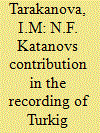

|
|
|
|
|
| Publication |
2013.
|
| Summary/Abstract |
Today the recording of languages is considered to be comparatively a new branch of linguistics, which is connected with field linguistics, i.e. with the study of languages in their natural habitation sphere. N. F.
Katanov may be rightfully named as a field scholar, who professionally approached the recording of languages. The main goal of recording is gathering and accumulation of primary data about poorly explored languages. It is especially now because their number is declining. As A. V. Arhipov notes, activity of a field linguist is aimed at description of 11 language, at direct study of the language phenomena, while various concrete research problems can be resolved. The goal of recording is to gather basic data, which would help to investigate a language hereafter (i.e. to resolve concrete research problems) even if it is impossible to get new data. Texts of different speech genres are fixed (stories, fairy-tales, legends, cases from life, etc.). N. F. Katanov may, therefore, be rightfully named as a true field linguist.
|
|
|
|
|
|
|
|
|
|
|
|
|
|
|
|
| 2 |
ID:
128489
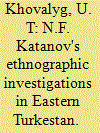

|
|
|
|
|
| Publication |
2013.
|
| Summary/Abstract |
By order of Russian Geographic Society and Russian Academy of Science, 'N. F. Katanov was preparing for the ethnographic and linguistic investigations in South Siberia, Kazakhstan and Eastern Turkestan. In December 1888 he visited a key region of the Yenisei, Uryankhai region for his research of the Tuvinians' (the Uryankhais and Soyons') language and culture, where he stayed till autumn of 1889. From there he went to the regions of rivers Agul, Biryusa and Uda to the Karagas people. There he had been working till April 1890. Later, the texts collected there were publishedl. From the Karagas people N. F. Katanov continued his travel to Semirechye, then in summer 1890 through Chuguchak to Urumchi, to the residency of a governor of Eastern Turkestan. He spent his winter and the beginning of 1891 in Tarbagatai, where having received emperor's letter from Beijing he started to travel around Gansu-Xinjiang again and got to Myao-orl-du (High monastery) which was situated a little bit more eastern from Komul. In March 1892 he hit the road from Komul to Turfan, from where he went through Urumchi, Gulja and through Semirechye again to Minusinsk from where he returned to Saint~Petersburg in December 1892. In Semirechye and Tarbagatai, Katanov researched the language and customs of the Kazakhs from kins kerei, argyn, naiman and Sarat citizens and in Chinese Turkestan he studied the language and traditions of the local Uygursz. In Germany there is some part of ethnographic and linguistic material which was collected by professor N. F. Katanov from the population of north-eastern part of Eastern Turkestan, whidi was famous in the written sources before as Uiguristan (country of the Uygurs).
|
|
|
|
|
|
|
|
|
|
|
|
|
|
|
|
| 3 |
ID:
128482
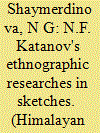

|
|
|
|
|
| Publication |
2013.
|
| Summary/Abstract |
Nickolay Fyodorovich Katanov is one of the outstanding scholar- Turcologists, a researcher of Ural-Altaic world. His creative work was devoted to multidimensional aspects of scientific activity: ethnography and history, linguistics and translation studies, literary studies and folklore, numismatics and museum work, archaeology and local lore. He was also a talented professor whose lectures drew numerous audience at Kazan University. In spite of the multidimensionality of N. F. Katanov's creative activity one of his main merits is the study and research of culture and ethnic world of the Turkic peoples in South Siberia, Eastern Turkestan and Central Asia. Katanov's collection during four years of his travels (1889-1892) of priceless material such as manuscripts and journal records testifies about it. Later these were published in Sketches of Uryzmkhai land.
|
|
|
|
|
|
|
|
|
|
|
|
|
|
|
|
| 4 |
ID:
128485
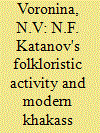

|
|
|
|
|
| Publication |
2013.
|
| Summary/Abstract |
N.F. Katanov's difficult, arduous folkloristic collection is of special value in literary studies and cognitive aspects in his extensive scienti?c, pedagogic, enlightening and social activity. Recorded and processed by an outstanding Khakass scholar, folklore texts are not only keepers and translators of the Turkic peoples' spiritual culture but they also accumulate creative work of Khakass poets and novelists. For example V. K. Tatarova (1952), a Khakass poet and novelist, distinguished public figure and famous theorist of Katanov studies wrote parables/ book of poems Cowberry on a palm in 1995 on the basis of materials of an ethnographic expedition around the Minusinsk depression carried out by N. F. Katanov in 1889-1892. It should be noted that "... in the sphere of the Turkic-speaking habitation of Siberia and Eastern Turkestan a researcher managed to collect a great linguistic, ethnographic and folklore material" which today is of
cognitive value as a collection of Turkic fairytales, fables, songs, proverbs and sayings. "Folklore materials were published in the IX volume of Folk literature samples of the Turkic tribes (St. Petersburgh, 1907) where folklore pieces of work of the Uryankhais (1,410 names), Khakasses (1,159 names), Karagases (203 names) were included"?
|
|
|
|
|
|
|
|
|
|
|
|
|
|
|
|
| 5 |
ID:
128488


|
|
|
|
|
| Publication |
2013.
|
| Summary/Abstract |
Actual position of the investigation of this territory was expressed in academician V. V. Radloff's words: "Importance of the investigation of the Turkic tribes' remains in the far east is unquestionable because these
countries have never been visited by experts of the Turkic languages. And we have only odd bits of information collected by outside observers who were not specially prepared for aimobjective".' In 1891 N. F. Katanov was sent by Imperial Saint-Petersburg Academy of Science and Imperial Russian Geographic Society to Eastern Turkestan as the most prepared specialist in the Turkic languages. The investigation of the territory was held in the framework of an investigation project of the Turkic tribes in Eastern Siberia, Mongolia and Northern China to analyse the Turkic tribes' language and household activities. At that time Eastern Turkestan or Uigurstan was a part of China as its northern region - Xinjiang which included Kashgaria (southern part) and Dzungaria (northern part). Population of this region comprised of different Turkic groups: the Turcomen- Uygurs and Kazakhs-Kirghiz worshiping Islam, the Mongolians-Oirats and Chinese Turcomen worshiping Buddhism, etc.
|
|
|
|
|
|
|
|
|
|
|
|
|
|
|
|
| 6 |
ID:
128490
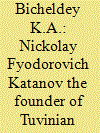

|
|
|
|
|
| Publication |
2013.
|
| Summary/Abstract |
Tuvinian studies is a comparatively new branch in Russian science and represents a set of scientific actions of collective and individual character. In a broader meaning it is a knowledge system about Tuva and the
Tuvinians. Its formation, further development and expansion are connected with the activity of Imperial Russian Geographic Society (IRGS) in the investigation and study of Central Asia in the second half of nineteenth and early twentieth century. The period from 1842 till 1945 can be conditionally called as "the
golden age" of Tuvinian studies. Undoubtedly it was preceded by a range of Tuvinian studies / researches in sixteenth to nineteenth centuries. In this period of history Russian empire strengthened the spread of its
geopolitical interests in Central Asia. Independent explorers and entire expeditions from Russia went to Mongolia, China and Tibet for different purposes including scientific ones. Frequently their pathway ran through the Uryankhai region (one of the former names of Tuva at that time), so explorers and researchers included Uryankhai (Tuva) in the plans of their investigations. Eventually general interest of the Russian empire and its scientific society in Central Asia led to the execution also of special investigations about Tuva.
|
|
|
|
|
|
|
|
|
|
|
|
|
|
|
|
| 7 |
ID:
128487
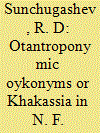

|
|
|
|
|
| Publication |
2013.
|
| Summary/Abstract |
In recent years in linguistics, investigation of proper names including anthroponymics and oykonymics has been developing extensively. Anthroponymics is a branch of onomastics, which studies anthroponyms
-personal names of people: proper names, patronymics (father's names or other names after father), surnames, tribal names, nicknames and pseudonyms (individual or group), cryptonyms (concealing names)';
oykonymics is a branch of toponymy, which studies oykonymsz, i.e. names of any settlements. These branches are still one of the poorly studied ?eld of Turkic onomastics. In Khakass toponymy considerable part of settlements' names belong to anthroponyms, i.e. proper names and surnames. Formed from anthroponyms, oykonyms give important information of linguistic, historical, ethnographical and ethnocultural nature. They point at the bygone settlement of peoples and tribes, reflect traditional folk culture
and change processes in the socio-political and economic life of people.
|
|
|
|
|
|
|
|
|
|
|
|
|
|
|
|
| 8 |
ID:
139538


|
|
|
|
|
| Summary/Abstract |
In this article, I would like to show that China’s rough treatment of Uyghurs is related not only to domestic tensions in Xinjiang but also to the legacy of Uyghurs’ association with the Soviet Union and Russia against China’s nationality policy. Both, but particularly Moscow, used the Uyghurs in their virtual propaganda and, moreover, also in actual acts of organizing outfits—mainly civilian but also military—including espionage, sabotage, and even preparations for invasion. While most—if not all—of these attempts failed, the memories of these actions still survive. Behind the apparent friendship between China and Russia today are hidden mutual suspicions as well as unsettled accounts going back as far as the seventeenth century. Given these potential, and occasionally actual, tensions and China’s growing economic advantage over Russia, a future conflict is an eventuality that should be taken into consideration, meaning that Uyghurs may become pawns in this playground yet again.
|
|
|
|
|
|
|
|
|
|
|
|
|
|
|
|
| 9 |
ID:
128483
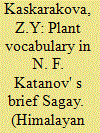

|
|
|
|
|
| Publication |
2013.
|
| Summary/Abstract |
Nickolay Fyodorovich Katanov was a great scholar, who gathered the richest material in ethnography, linguistics and folklore, providing a valuable source for studying different sides of the Turkic peoples' life, including Khakasses. Being a linguist- Turcologist N. F. Katanov started his scientific work with the study of the Khakass language, which he spoke, and relying on its knowledge, he began to research other related kind red languages. During his study in Krasnoyarsk high school, he went to various places every year, gathered folklore, linguistic texts and described the customs of the Sagay people. A researcher of the Tatar language D. G. Tumasheva notes: "Nicloloy Fyodorovich was not only an educated and intelligent man but he had his own material, which had been written by him from the first hand through direct contact with the people. N. F. Katanov laid emphasis on the latter, considering the necessity to study a language by means of direct interaction with the people and not by separating history of a language from ethnography, folklore and history of material culture."
|
|
|
|
|
|
|
|
|
|
|
|
|
|
|
|
| 10 |
ID:
128486


|
|
|
|
|
| Publication |
2013.
|
| Summary/Abstract |
The first information about the Khakass dialects and their phonetics is contained in pre-revolutionary sources, first of all in the works of M. A. Castren, V.V. Radloff, N. F. Katanov. In his work Versuch einer koibalischerz und karagassischerz Sprczchlehrel M. A. Castren described the Koybal dialect of the Khakass language; in the section Phonetics, he details the composition of vowels and consonants of the dialect. Next researcher in the phonetics of the Khakass dialects is V. V. Radloffz. It is for the first time in the history of Tu rcology, that he represented the entire classification of sound structure of the Turkic languages-'. I_ However, one of the most famous representatives of pre-October h Khakass studies is N. F. Katanov.
|
|
|
|
|
|
|
|
|
|
|
|
|
|
|
|
|
|
|
|
|